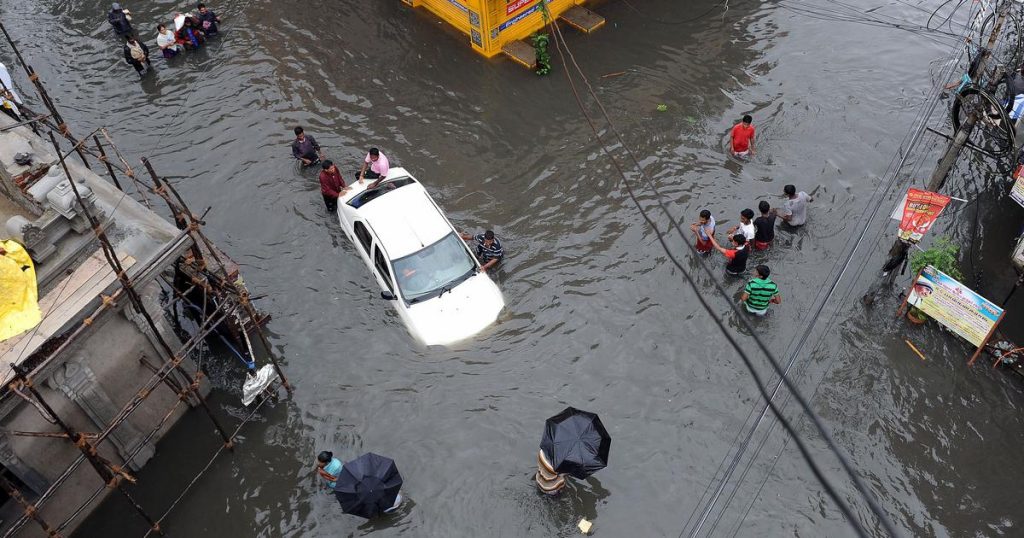WATER AND CLIMATE CHANGE - LESSONS LEARNT FROM CHENNAI FLOODS

BY APARNA VENKATARAMAN
To those of you who are unaware of the “Chennai floods”, let me explain. Chennai floods is colloquially used to refer to the 2015 floods that happened in the South Indian states of Tamil Nadu and Andhra Pradesh and the Union Territory of Puducherry. Chennai is at the northern most point of Tamil Nadu and so, geographically speaking, the southern parts of the state of Andhra Pradesh were affected as well.
I was in my 11th grade in 2015. One day, I woke up to see the sky dark and gloomy and an almost constant downpour. As any school student, my fervent prayer was the day to be declared as a holiday. So as soon as possible, I sat in front of the TV watching the news channels for the then Weather Forecaster Mr. SR Ramanan. And lo and behold, my wishes were granted. Thinking that this was a one-time event, I spent the day doing nothing “productive” (according to my parents). The next day too, the same trend continued. I was overjoyed for being relieved of school for two continuous days, for this was next to impossible when you are in 11th grade, in Chennai, and particularly when it is a CBSE school. To my surprise, this trend continued for more than a week! By then, it had come to everyone’s notice that this was no normal rains, and also that it was flooding the city. I started going to bed with the knowledge that the next day will also be a holiday, which proved to be true. Due to the bad weather conditions, there were frequent bouts of lack of electricity, Wi-Fi, and TV (3 important things, according to a 11th grader). But as and when we were able to view the news channels on TV, we saw the massive destruction wrought to the people of Chennai. I realised how privileged I was, for I only had to worry about eating foods that I disliked, and not the fact that I did not have any food itself on my plate.
At this juncture, my family decided to help the people most affected by the floods. We were able to identify an NGO whose base of operations was quite close to our house and approached them. They gave us a list of materials that they were in shortage of. One of those was a particular medicine that had seemingly disappeared from the shelves of the pharmacies across Chennai. This medicine was similar to an anti-fungal and an anti-bacterial cream which was to be applied on the skin of the people most affected. Fungal and bacterial infections were on the rise because of the constant exposure to the water, which was most likely contaminated in some form too. After a lot of calls and constant search, we were able to locate that medicine and gave it to the NGO representatives, who showered us with gratitude. This once again made me realise how privileged I was. We also decided to contribute food, and hence procured biscuits for them, because they were packaged well, easy to source, and would also not cause too many stomach problems. I later started wondering about how this entire incident came to being. Why was Chennai flooded to such an extent? There were reports suggesting that Chennai had faced unprecedented rainfall. But was the rainfall of such a magnitude that the city was flooded?
There were news reports stating that an ‘El Nino’ had played an impact on the Chennai floods. What was an El Nino? I found out that it referred to the climate changing in the oceans, as a result of which there are repercussions on global weather. Here, it is important to know how oceans are important in controlling the weather. Oceans are responsible for heat distribution across the world. As we all know, at least 70% of the world is water. This water, due to its constant contact with the sun starts getting heated and soon starts evaporating constantly. This causes the temperature of the earth to rise. It also increases the humidity in the air, which ultimately results in rainfall across the world.
Coming back to El Nino – this is a phenomenon that is quite common in the southern hemisphere and is not the norm. El Nino generally occurs once in two to seven years, but it is not predictable. It affects ocean temperatures, which in itself has a monumental impact on global weather patterns, because this means that land temperatures increase as well.
Generally the water starts becoming warm in the western tropical Pacific Ocean and shifts eastward. If not for the El Nino, a situation called upwelling occurs which ultimately results in creation of the food cycle in the ocean, which benefits all creatures of the ocean. Upwelling gets disrupted when an El Nino occurs, which apart from harming the ocean environment, it also drastically harms the economies of South American countries because it causes floods to break out. El Nino is also known to impact other nations of the world as well, for Indonesia and Australia tend to face droughts because of it. The heat generated through the El Nino ultimately results in serious and severe weather conditions across the globe, such as massive heatwaves, droughts, and flooding. The strength of the El Nino is proportionate to the damage caused. The World Meteorological Department, headquartered in Geneva, had confirmed that 2015 recorded the hottest temperatures ever. (As of 2015) The current data suggests that, 2016 was the hottest year, followed by 2019.
Shifting the focus to India, one has to keep in mind that India predominantly receives rainfall from the South-West monsoon (typically from June to September), with Tamil Nadu and Puducherry being the exceptions. These places receive its rainfall from the North-East monsoon (typically from October to December) instead. From 2014-15 data, it is clear that India received 12% shortage of rainfall, and 2015-16 saw that number increase to 14%. This shortage saw eight states declaring the onslaught of a ‘drought’ as well.
Looking at this data, one can see the warring weather conditions. Andhra Pradesh had officially declared that the state was going through drought, whereas the southern most points of the state were actually experiencing floods! This kind of a situation is further exacerbated by the major climate change crisis that the world is going through. El Nino is known to be the cause of decreasing South-West monsoon levels and increasing the levels of the North-East monsoon. This event contributed almost 21% to the floods, while another major factor was that of the warming of the Bay of Bengal. One has to keep in mind that while El Nino did play a major role in the creation of the flood (there was increase in temperatures in the Indian Ocean), the damage caused by it was so huge because of human actions. Human actions or inactions is the major contributor for climate change. Bad structural planning was the actual contributor of more damage and lives lost rather than the El Nino and the warming of the Bay of Bengal. There was no proper mechanism created for the excess water to be drained in the city, which caused the floods.
Climate change did not leave Chennai just with the 2015 floods. There was the 2019 water crisis as well, which led to people treating water with frugality. It has to be noted that such a situation was reported across India as well as the world too. Chennai has four main reservoirs and as of 21st of June 2019, they were operating at 0.2% of their capacity. The water that had been collected and stored at the time of the floods were used up completely in 2019. The Chennai Metropolitan Water Supply and Sewage Board was only able to supply a little more than half of the daily requirement of the city. In fact, there were memes being circulated that pointed out that coffee and other drinks were tasting so much better because there was absolutely no water being added to it. Late 2018 and early 2019 also saw us making a household change – opting for canned water, instead of using the water filter in the house. This is clearly a huge step back, and a direct consequence of lack of water in Chennai. Plus, the bathing water in my complex used to give different colours of water. I would check the colour every day, just for the fun of it (remember ‘privilege’?).
This drought like situation was because of 2 major reasons – one, almost negligible rainfall, and two, intense heatwaves. Plus, the groundwater is also being used up very quickly, without giving it a chance to replenish itself. The only solution has been to procure water from elsewhere using tankers. Such a shortage of water has resulted in people spending almost half or more of their income on water alone. I have heard of this story where due to a dispute between neighbours, one person left the tap open in their house and drained the overhead tank after he left the premises! A friend of ours told us that canned drinking water had to be used in parlours to wash the hair of the customers, and this was because the building just stopped receiving water suddenly.
The ultimate consequence of this situation to me is that I have become paranoid about water. I use as minimum water as possible for everything – bathing, brushing my teeth, hand washing, and so on. I learnt to wash vessels using bare minimum water, that is, by letting the water trickle from the tap, which definitely took a longer time, but gave me the satisfaction of saving water. Time has come for individual actions to be the trend setter for saving water, and thereby the environment. Small actions of everybody can quite literally change the world for everybody.
ABOUT THE AUTHOR
Aparna Venkataraman
Aparna Venkataraman, a would be lawyer from Tamil Nadu National Law University. A feminist with bold views and opinions, she specialises in bringing about a change one person at a time. This special woman is loyal, spontaneous and vocal about her love for life and all it brings. She is always exploring and loving everything there is. She’s also a voracious reader who explores various realms of fantasy, it’s fanfictions and get frequently influences the ones around her to do the same!




Aparna, well written. For me totally informative.